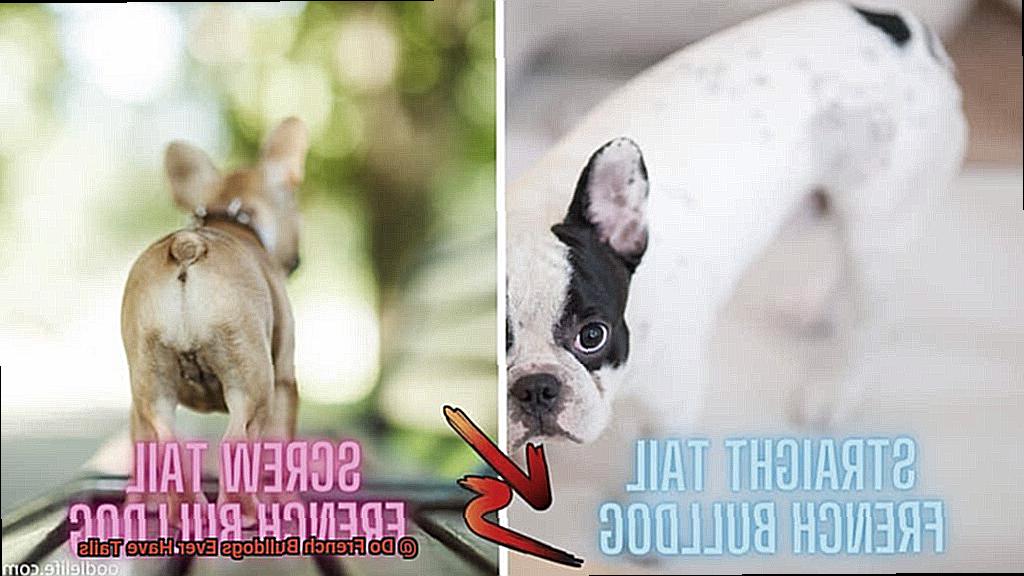Do French Bulldogs Ever Have Tails?
Are you as captivated by the irresistible charm of French bulldogs as I am?
These little bundles of joy have a look that’s all their own, and a personality that can melt even the coldest heart. But here’s something that might make you do a double-take – their tails, or lack thereof.
Yep, you heard me right. Do French bulldogs ever have tails?
Contents
- 1 Do French bulldogs ever have tails
- 2 The Different Types of French Bulldog Tails
- 3 Genetics and the Natural Bobtail Gene
- 4 Tail Docking: Pros and Cons
- 5 Health Implications of Tail Docking
- 6 Finding a Reputable Breeder
- 7 The Benefits of Having a Tail on a French Bulldog
- 8 Understanding the Legalities of Tail Docking
- 9 How to Tell if Your French Bulldog Has a Tail or Not
- 10 Conclusion
It’s a question that has sparked debates among dog lovers and left us scratching our heads in confusion. Well, today we’re going to dig deep into the world of Frenchies and uncover the truth about their tails.
So, grab your four-legged friend, get comfy, and join us on this wild ride.
Do French bulldogs ever have tails
In this article, we’ll delve into the fascinating world of French Bulldog tails, exploring the reasons behind their distinctive appearance and what it means for their health and well-being.
The Genetics Behind the Short Tail:
French Bulldogs are born with a naturally short tail, often referred to as a “screw tail” or a “stumpy tail.” This characteristic is the result of selective breeding over generations to achieve the desired appearance of the breed. The short tail is typically straight or slightly curved and is usually carried low.
Occasional Exceptions:
While most French Bulldogs have naturally short tails, there are rare cases where some individuals may be born with a longer tail. This occurrence, known as a “long-tail gene,” is considered an anomaly within the breed. These French Bulldogs with longer tails often come from mixed-breeding or carry genes from other dog breeds that have longer tails.
Health and Temperament:
The presence of a longer tail in a French Bulldog does not impact their overall health or temperament. It is purely a cosmetic difference that does not affect their ability to function or interact with humans and other animals. So, if your French Bulldog happens to have a longer tail, rest assured that they’re just as healthy and lovable as their short-tailed counterparts.
Tail Care Tips:
If you have a French Bulldog with a longer tail, it’s vital to provide proper care and attention to maintain its hygiene and prevent any discomfort or injuries. Here are some tips:
- Regular Grooming: Clean the tail area regularly, paying attention to any buildup of dirt or debris.
- Trimming the Fur: Keep the fur around the tail trimmed to prevent it from becoming matted or tangled.
- Hygiene Maintenance: Ensure that the tail area is kept clean and dry to avoid any potential skin irritations or infections.
Tail Docking: A Controversial Practice:
It’s worth mentioning that tail docking, the surgical removal of a dog’s tail, is illegal or restricted in many countries. However, some breeders may still engage in this practice for various reasons, including adherence to breed standards or aesthetics. Responsible breeders and dog owners should prioritize the welfare and well-being of their French Bulldogs and avoid unnecessary tail docking procedures.
The Different Types of French Bulldog Tails
French Bulldogs are beloved for their adorable looks and unique features, including their short and stubby tails. However, did you know that not all French Bulldogs have the same type of tail? In fact, there are three main types of French Bulldog tails: the screw tail, the straight tail, and the corkscrew tail. Let’s dive into each type and learn more about their characteristics.
The Screw Tail:
The screw tail is the most common type of tail seen in French Bulldogs. It is short, curly, and resembles a corkscrew. This cute little tail sits low on the body and is often carried in a tight spiral over the back. It adds to the overall charm and appeal of French Bulldogs, making them even more irresistible.
The Straight Tail:
While less common than the screw tail, some French Bulldogs have straight tails. As the name suggests, these tails are straight and do not have any curl or spiral to them. They are also set low on the body but are carried more horizontally rather than over the back. Straight-tailed French Bulldogs have a sleek and elegant look that sets them apart.
The Corkscrew Tail:
The corkscrew tail is a unique combination of the screw tail and the straight tail. It starts straight and then curls at the end, resembling a cork being twisted. This type of tail is less common but can be found in certain bloodlines. If you come across a French Bulldog with a corkscrew tail, consider yourself lucky to witness this rare beauty.
Natural Bobtails:
It’s important to note that not all French Bulldogs have tails. Some are born with a natural bobtail, which means they are born without a tail or with a very short tail. This can be due to genetics or selective breeding by breeders. While having a natural bobtail doesn’t affect a French Bulldog’s health or temperament, it adds to their uniqueness.
Tail Docking:
In some countries, tail docking is still practiced for French Bulldogs. However, many countries have banned or restricted this practice due to concerns about animal welfare. It’s essential to consider the potential health implications and consult with professionals before making any decisions regarding your French Bulldog’s tail.
Genetics and the Natural Bobtail Gene
French Bulldogs are known for their distinctive appearance, and one of the features that make them truly special is their tail. While most Frenchies have short and stubby tails, some are born with a natural bobtail or even no tail at all. In this blog post, we will explore the genetics behind the natural bobtail gene in French Bulldogs, how it is inherited, and the considerations for responsible breeding.
The Inheritance of the Natural Bobtail Gene:
The natural bobtail gene in French Bulldogs is inherited in an autosomal dominant manner. This means that if one parent carries the gene, there is a 50% chance that their offspring will also have a natural bobtail. However, it’s important to note that not all French Bulldogs with short tails have the natural bobtail gene. Other genetic factors can also contribute to a naturally shortened tail.
Breeding for Natural Bobtails:
Breeders who are interested in producing French Bulldogs with natural bobtails should carefully select parent dogs that carry the gene. Breeding two French Bulldogs with natural bobtails increases the likelihood of producing offspring with the same trait. However, it is crucial to prioritize the health and genetic diversity of the dogs involved to avoid potential health issues associated with excessive inbreeding.
Health Implications:
The good news is that having a natural bobtail does not have any detrimental effects on the overall health or well-being of French Bulldogs. In fact, some owners find it visually appealing and see it as a unique characteristic of their pet. However, responsible breeders should always work closely with veterinarians and geneticists to ensure the well-being of both parent dogs and their offspring.
Appreciating Diversity:
Whether your French Bulldog has a natural bobtail or not, every Frenchie is special in their own way. Understanding the genetics behind the natural bobtail gene allows us to appreciate the diversity within the French Bulldog population and make informed decisions as owners and breeders.
Tail Docking: Pros and Cons
Tail docking is a controversial topic in the French Bulldog community, as it involves the removal of a portion of the dog’s tail. While some breeders and owners argue in favor of tail docking for aesthetic appeal, hygiene, and injury prevention, others raise ethical concerns and potential health risks. In this article, we will explore the pros and cons of tail docking for French Bulldogs to help owners make an informed decision.
Pros of tail docking:
Aesthetic appeal:
- The breed standard for French Bulldogs often calls for a naturally short or “screw” tail.
- Docking the tail can create a more balanced and symmetrical appearance, enhancing the dog’s overall aesthetic appeal.
Hygiene and cleanliness:
- French Bulldogs are known for their deep skin folds around their tails, which can trap dirt, moisture, and bacteria.
- Removing the tail through docking may help minimize these problems, making it easier to keep the area clean and reducing the risk of infections.
Injury prevention:
- Due to their compact bodies and protruding tails, French Bulldogs are prone to accidental injuries.
- Docking the tail can help minimize the risk of injuries such as getting caught in doors or furniture or being stepped on by humans or other pets.
- This is particularly important in households with small children or other pets where accidental injuries are more likely to occur.
Cons of tail docking:
Ethical concerns:
- Some argue that tail docking is an unnecessary and painful procedure that infringes upon a dog’s natural anatomy.
- It is considered by some as a form of cosmetic surgery that does not provide any significant benefit to the dog.
- There are ethical questions regarding performing such procedures without considering the dog’s welfare or obtaining their consent.
Potential health risks:
- Docking a dog’s tail involves cutting through bone, cartilage, nerves, and blood vessels.
- This can lead to complications such as infection, excessive bleeding, and improper healing.
- The risk of complications may be higher if the procedure is not performed by a skilled and experienced veterinarian.
Communication and expression:
- Dogs communicate with their tails, using them to express emotions and intentions.
- By removing the tail, a dog’s ability to communicate effectively may be compromised.
- Owners and other dogs may find it more difficult to understand their body language and intentions, potentially leading to misunderstandings or conflicts.
Health Implications of Tail Docking

As an expert in the field, I’m here to shed some light on this controversial topic. So, grab a cup of coffee and let’s dive in.
Infections: A Pain in the Tail
When a French bulldog’s tail is docked, the surgical site becomes vulnerable to infections. These infections can cause pain, swelling, and discomfort for your furry friend. In severe cases, the infection may spread to other areas of their body, requiring immediate medical attention.
Lost in Translation: The Importance of Communication
Imagine trying to express yourself without using words or gestures. That’s what happens when a French bulldog’s tail is docked. Their tails play a crucial role in communicating with other dogs, and without it, they may struggle to express their emotions effectively. This can lead to misunderstandings and potential conflicts with other pooches.
Balance Beam: Tails as Stabilizers
Did you know that a dog’s tail helps them maintain balance during quick movements or changes in direction? Without a tail, French bulldogs might find it challenging to keep their balance, increasing the risk of falls and injuries.
Chronic Pain: A Lingering Consequence
During tail docking, nerves and tissues are severed, causing long-term discomfort and sensitivity in the docked area. This chronic pain can negatively impact your French bulldog’s overall well-being and quality of life.
Psychological Implications: The Silent Struggle
Dogs use their tails to express emotions like happiness, fear, or aggression. With their tails removed, French bulldogs may find it difficult to convey their feelings effectively, potentially leading to frustration or behavioral issues.
Global Perspectives: Banning the Dock
Many countries and jurisdictions have banned or restricted tail docking due to these health concerns. Veterinarians and animal welfare organizations advocate against tail docking unless it is medically necessary.
Finding a Reputable Breeder
When it comes to finding a reputable French Bulldog breeder, doing thorough research and asking the right questions is crucial. Here are some key points to consider in your quest for a trustworthy breeder:
- Start with Research: Begin by checking national or local breed clubs or organizations for a list of recommended breeders. These organizations often have strict guidelines that breeders must adhere to, ensuring they are knowledgeable and ethical.
- Health Testing and Transparency: Reputable breeders will be transparent about the health issues that can affect French Bulldogs. They will provide documentation of health testing done on their breeding dogs, such as hip and elbow evaluations, eye examinations, and genetic testing for common breed-related conditions.
- Visit the Breeder: A reputable breeder will allow potential buyers to visit their facilities and meet the puppies and their parents in person. This will give you an opportunity to assess the living conditions of the dogs, their temperament, and overall well-being.
- Breed Standard: A reputable breeder will have a thorough understanding of the breed standard and strive to produce puppies that conform to these standards. They will prioritize breeding for health, temperament, and conformation.
- Ongoing Support: A reputable breeder will provide ongoing support and guidance to buyers. They will offer information on proper care, training, and socialization of the puppy. They should also be available to answer any questions or concerns that may arise throughout the dog’s life.
- Beware of Red Flags: Be cautious of breeders who prioritize profit over the well-being of their dogs. Watch out for breeders who cut corners on health testing or breed dogs excessively without proper care and socialization.
- Online Resources: Utilize online resources such as breeder directories and reviews, but be sure to verify the information and do additional research before making a decision.
- Compare and Contrast: It’s a good idea to visit multiple breeders and compare their practices, facilities, and overall reputation. This will help you make an informed decision and find the best fit for your needs.
- Application and Contract: Reputable breeders may require potential buyers to fill out an application or go through an interview process to ensure their puppies are going to suitable homes. They may also have a contract that outlines responsibilities for both the breeder and the buyer, including provisions for health guarantees, return policies, and spaying/neutering requirements.
The Benefits of Having a Tail on a French Bulldog
French Bulldogs are known for their adorable and unique appearance, including their short and stubby tails. However, did you know that some French Bulldogs are born with a longer tail? In this post, we’ll explore the benefits of having a tail on a French Bulldog and why it can be an asset to your furry friend.
Improved Balance and Agility
Just like how a tightrope walker uses a pole to maintain balance, a French Bulldog’s tail acts as a counterbalance. It helps them stay stable while walking, running, or playing. This is especially important for French Bulldogs, as their compact and muscular body structure can sometimes make them prone to tipping over. With a tail, they have an extra tool to keep themselves upright and nimble.
Enhanced Communication
Dogs use their tails as a means of communication, and having a tail allows a French Bulldog to express themselves more effectively. A wagging tail is often a sign of happiness or excitement, while a tucked tail may indicate fear or anxiety. By having a tail, your French Bulldog can better communicate their emotions and intentions to other dogs and humans, enhancing their social interactions.
Added Protection
A tail provides added protection for a French Bulldog’s rear end. It acts as a natural shield against potential injuries or accidents, such as bumps or falls. It also helps protect sensitive areas like the anus from direct contact with surfaces or objects. Having a tail can give you peace of mind knowing that your furry friend has an extra layer of defense.
Aesthetic Appeal
While short and stubby tails are the norm for French Bulldogs, those with longer tails offer a unique and eye-catching appearance. Some owners prefer the look of a French Bulldog with a tail as it adds variety to the breed’s appearance. It also opens up more options for grooming styles and tail accessories like bows or bandanas, allowing you to showcase your French Bulldog’s individuality.
Overall Well-being and Happiness
Just like humans, dogs need to express themselves physically and emotionally. Having a tail provides a French Bulldog with an additional means of self-expression, allowing them to feel more comfortable and content in their environment. A happy and fulfilled French Bulldog makes for a happy owner too.
Understanding the Legalities of Tail Docking
Tail docking, the practice of removing a portion of a dog’s tail, has long been a topic of debate in the canine community. As a French Bulldog owner, it’s important to be aware of the legalities and ethical considerations surrounding tail docking in your country or region.
Legalities Vary by Country and Region
The legality of tail docking varies from country to country and even within different regions or states. In countries like the United Kingdom and many European countries, tail docking is considered illegal unless it is performed for medical reasons. This means that as a French Bulldog owner in these countries, you cannot legally have your dog’s tail docked for cosmetic purposes.
Exceptions for Working Dogs
However, there are exceptions to this rule in certain circumstances. For example, working dogs that are used for specific jobs like hunting or herding may be exempt from the ban on tail docking. These dogs may still undergo tail docking for practical reasons related to their work.
Tail Docking Regulations in the United States
In the United States, tail docking regulations differ from state to state. Some states have completely banned the practice except for medical reasons, while others allow it for specific breeds or working dogs. As a French Bulldog owner in the U.S., it is important to research and understand the regulations in your particular state before considering tail docking.
Ethical Considerations
The primary argument against tail docking is that it is a form of cosmetic alteration that causes unnecessary pain and distress to the dog. Opponents argue that dogs are born with tails for a reason and that removing them can have negative physical and psychological effects.
Proponents of tail docking argue that it is necessary for certain breeds to conform to breed standards or to prevent injuries in working dogs. They believe that when performed correctly, tail docking is a minor procedure with minimal long-term effects on the dog’s well-being.
Consulting with a Veterinarian
As a responsible French Bulldog owner, it is crucial to consult with a veterinarian and familiarize yourself with local regulations before making any decisions regarding tail docking. Your veterinarian can provide guidance on the legalities and ethical considerations specific to your region.
How to Tell if Your French Bulldog Has a Tail or Not
French Bulldogs are beloved for their adorable appearance and unique traits, including their short and stocky bodies, bat-like ears, and expressive eyes. However, one aspect that often confuses people is their tail. Do French Bulldogs have tails or not? Let’s dive into this fascinating topic and discover the truth behind their tail tales.
Understanding the Screw Tail:
French Bulldogs are famous for their screw tails, which are short and curly. This genetic trait is a result of selective breeding over many generations. To determine if your Frenchie has a tail, gently feel along the base of their spine. You may notice a small bump or a few vertebrae, indicating the remnants of their tail.
The Case of the Invisible Tail:
Not all French Bulldogs have visible tails. Some may have tails so short that they are not easily seen, while others might have no tail at all. It’s important to be gentle and observant when checking for a tail, avoiding any discomfort for your furry friend.
Consult with a Veterinarian:
If you’re still unsure about your French Bulldog’s tail, it’s always wise to consult with a veterinarian. They can provide accurate assessments and address any concerns you may have. Remember, veterinarians are the experts when it comes to your pet’s health.
The Breed Standard:
The breed standard set by kennel clubs like the AKC or UKC describes French Bulldogs as having “undocked tails that are thick at the root and taper quickly toward the tip.” Observing your Frenchie’s tail against this description can offer further insights into whether they have a tail or not.
Tail Docking Controversy:
Tail docking is a practice where part of the tail is surgically removed shortly after birth. While some breeders choose to dock French Bulldogs’ tails for aesthetic purposes, it is a controversial topic. Consider the potential health implications and consult professionals before making any decisions regarding your Frenchie’s tail.
Conclusion
French bulldogs are known for their adorable and distinctive appearance. One question that often comes up is whether or not they have tails. Well, the answer is no – French bulldogs do not have long, wagging tails like many other dog breeds. Instead, they have what is called a “screw tail.” This unique feature is a short and tightly curled tail that sits low on their hindquarters. It adds to their charm and makes them even more endearing.
The absence of a long tail in French bulldogs is actually a result of selective breeding. Many years ago, breeders wanted to create a compact and muscular dog with a friendly and affectionate personality. As part of this process, they intentionally bred French bulldogs with shorter tails, resulting in the adorable screw tail we see today.
The screw tail serves a practical purpose as well. It helps balance the weight distribution of the dog’s body, which can be quite heavy compared to its size. Additionally, the screw tail doesn’t interfere with the dog’s movement or cause any discomfort.
So if you’re considering adding a French bulldog to your family, rest assured that you won’t need to worry about dealing with a long, wagging tail. Instead, you’ll get to enjoy the unique and charming presence of their cute little screw tails. These delightful dogs are sure to bring joy and laughter into your life with their playful personalities and unmistakable appearance.
In conclusion, while many dog breeds boast long and wagging tails, French bulldogs have their own special twist – the adorable screw tail. This distinctive feature not only adds to their charm but also serves practical purposes without causing any discomfort.




